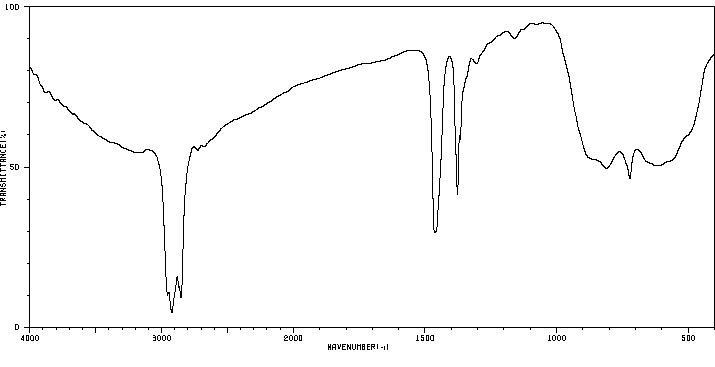niobium oxide
分子结构分类
中文名称
——
中文别名
——
英文名称
niobium oxide
英文别名
2,4,5-Trioxa-1lambda5,3lambda5-diniobabicyclo[1.1.1]pentane 1,3-dioxide;2,4,5-trioxa-1λ5,3λ5-diniobabicyclo[1.1.1]pentane 1,3-dioxide
CAS
——
化学式
Nb2O5
mdl
——
分子量
265.81
InChiKey
ZKATWMILCYLAPD-UHFFFAOYSA-N
BEILSTEIN
——
EINECS
——
-
物化性质
-
计算性质
-
ADMET
-
安全信息
-
SDS
-
制备方法与用途
-
上下游信息
-
文献信息
-
表征谱图
-
同类化合物
-
相关功能分类
-
相关结构分类
计算性质
-
辛醇/水分配系数(LogP):-0.55
-
重原子数:7
-
可旋转键数:0
-
环数:0.0
-
sp3杂化的碳原子比例:0.0
-
拓扑面积:77.5
-
氢给体数:0
-
氢受体数:5
反应信息
-
作为反应物:描述:niobium oxide 、 ammonium hydrogen difluoride 以 neat (no solvent) 为溶剂, 生成 ammonium oxohexafluoroniobate参考文献:名称:Balabanov, Yu. I.; Agulyanskii, A. I.; Agulyanskaya, L. A., Journal of General Chemistry of the USSR,
1983, vol. 53, p. 2195 - 2198摘要:DOI: -
作为产物:描述:参考文献:名称:电纺氧化铌纳米纤维的合成及光催化活性摘要:图形摘要:电纺氧化铌纳米纤维具有不同的相结构,得到了不同的形态。两相结构的纳米纤维呈现不同的带隙值和光吸收。与正交相纳米纤维相比,六方相纳米纤维显示出更好的光催化活性。亮点: ► 两相结构的氧化铌纳米纤维是通过静电纺丝制造的。► 首次探索了氧化铌纳米纤维的光催化性能。► 不同相结构的纳米纤维表现出不同的光催化活性。► 仔细讨论了光催化差异的原因。- 摘要:氧化铌 (Nb{sub 2}O{sub 5}) 纳米纤维已通过基于溶胶-凝胶的静电纺丝技术合成。纯六方相(H-Nb{sub 2}O{sub 5})和正交相(O-Nb{sub 2}O{sub 5})纳米纤维是通过对静电纺丝 Nb{sub 2}O{sub 进行热退火获得的5}/聚乙烯吡咯烷酮复合纤维分别在 500 °C 和 700 °C 的空气中。使用 X 射线衍射、扫描电子显微镜、比表面积分析仪和紫外可见漫反射光谱对纤维进行了表征。根据甲基DOI:10.1016/j.materresbull.2012.11.074
-
作为试剂:描述:nickel(II) bromide trihydrate 、 4,4'-联吡啶 、 silicotungstic acid hydrate 在 niobium oxide 、 水 作用下, 以 aq. buffer 为溶剂, 反应 120.0h, 以86%的产率得到[Ni2(4,4'-BPy)5(Br)2][H2SiW12O40].3H2O参考文献:名称:The syntheses, structures and characterizations of a series of frameworks constructed from polyoxometalates, metals and organic units摘要:五种杂化化合物[Ni2(4,4′-bpy)5(H2O)2][HBW12O40]·5H2O (1), [Ni2(4,4′-bpy)5(Cl)2][H2SiW12O40]·3H2O (2), [Ni2(4,4′-bpy)5(Br)2][H2SiW12O40]·3H2O (3), [SiW12O40]3[Cu2(4,4′-bpy)7]·(H24,4′-bpy)2·4H3O·2H2O (4)和[SiW12O40]3[Cd2(4,4′-bpy)7]·(H24,4′-bpy)2·4H3O·2H2O (5)由多金属氧酸盐、过渡金属和有机配体构建而成,并且通过红外、紫外-可见光、XPS、XRD、TG、圆二色性、二级非线性光学(NLO)测量、光致发光测量和单晶X射线衍射分析进行了表征。X射线衍射分析揭示了这五种化合物均展示了由多金属氧酸盐、过渡金属和有机配体构建的新颖框架结构。化合物1、2、3是同构的,化合物4和5也是同构的。前三种化合物主要有两个区别。它们的第一个区别在于Keggin离子的中心原子:化合物1是B原子,而化合物2和3是Si原子。它们的第二个区别是单齿配体与Ni离子的配位:化合物1是水分子,化合物2是氯离子,化合物3是溴离子。化合物4和5之间的区别在于框架的过渡金属中心。此外,化合物4和5是首次含有Keggin离子和伪Keggin离子的化合物的例子。DOI:10.1039/c2ce26477c
文献信息
-
Highly selective CO<sub>2</sub> removal for one-step liquefied natural gas processing by physisorbents作者:David G. Madden、Daniel O’Nolan、Kai-Jie Chen、Carol Hua、Amrit Kumar、Tony Pham、Katherine A. Forrest、Brian Space、John J. Perry、Majeda Khraisheh、Michael J. ZaworotkoDOI:10.1039/c9cc00626e日期:——
Industrial specifications require CO2 concentrations in natural gas below 50 ppm during liquefaction because of corrosion and CO2 freezing.
-
Oxidation of terpenic alcohols with hydrogen peroxide promoted by Nb2O5 obtained by microwave-assisted hydrothermal method作者:Daniel Carreira Batalha、Natália Hadler Marins、Ricardo Marques e Silva、Neftalí Lenin Villarreal Carreño、Humberto Vieira Fajardo、Márcio José da SilvaDOI:10.1016/j.mcat.2020.110941日期:2020.6The present work describes the synthesis of niobium oxides by microwave-assisted hydrothermal method and their evaluation as a solid catalyst in oxidation reactions of terpenic alcohols with hydrogen peroxide. Effects of main parameters of synthesis were assessed and all the prepared catalysts were characterized by physical adsorption/ desorption analyses of nitrogen, infrared and Raman spectroscopies本工作描述了微波辅助水热法合成铌氧化物及其作为固体催化剂在萜类醇与过氧化氢的氧化反应中的评价。评估了主要合成参数的影响,并通过氮气,红外和拉曼光谱的物理吸附/解吸分析,扫描电子显微镜和粉末X射线衍射分析对所有制备的催化剂进行了表征。通过电位滴定法确定催化剂的酸性部位的强度和数量。形态和结构表征与铌氧化物实现的活性和选择性相符。评估了催化剂的可重复使用性。评估了主要反应变量(例如温度,催化剂和氧化剂负荷)的影响。氧化铌被证明是一种有效的催化剂,能选择性地将神经醇(模型分子)转化为环氧化物和醛。研究了各种萜烯醇的氧化。仅香叶醇和神经醇被选择性地环氧化,表明羟基辅助反应。尽管芳樟醇也是烯丙醇,但由于在与羟基相同的碳原子上存在甲基,芳樟醇对环氧化不反应。使用对环境友好的廉价氧化剂(H 由于在与羟基相同的碳原子上存在甲基,芳樟醇对环氧化反应没有反应。使用对环境友好的廉价氧化剂(H 由于在与羟基相同的
-
Preparation, formation mechanism, photocatalytic, cytotoxicity and antioxidant activity of sodium niobate nanocubes作者:Muhammad Nawaz、Sarah Ameen Almofty、Faiza QureshiDOI:10.1371/journal.pone.0204061日期:——A hydrothermal method was employed to prepare the sodium niobate (NaNbO3) nanocubes. We executed time dependent experiments to illustrate the formation mechanism of sodium niobate nanocubes. It was observed that the morphology of NaNbO3 nanocubes was dependent on the reaction time and 12hr reaction time was found to be suitable. Morphology, composition, structure and optical properties of sodium niobate nanocubes were evaluated by scanning electron microscope, X-ray energy-dispersive spectrometer, X-ray diffraction and UV-visible diffuse reflectance spectrometer. The photocatalytic activity of sodium niobate was studied for photocatalytic hydrogen production. It was anticipated that the sodium niobate (NaNbO3) cubes exhibited good photocatalytic activity under UV light irradiation using lactic acid as sacrificial agent. The cytotoxicity activity of sodium niobate nanocubes was studied as well at different concentrations (5 mg/mL, 3 mg/mL, 1 mg/mL, and 0.25 mg/mL) against human colon colorectal carcinoma cell line (HCT116) by MTT assay and EC50 was found to be 1.9 mg/mL. Sodium niobate proved to be a good DPPH free radical scavenging material, tested at different concentrations. It was noticed that peak intensity at 517 nm was decreased after 30 minute incubation, further supporting the antioxidant activity. This study will be useful for design and engineering of materials that can be used in biomedical applications and in photocatalysis.我们采用水热法制备了铌酸钠(NaNbO3)纳米立方体。我们进行了时间依赖性实验,以说明铌酸钠纳米立方体的形成机制。观察发现,纳米铌酸钠立方体的形态与反应时间有关,12 小时的反应时间是合适的。利用扫描电子显微镜、X 射线能量色散光谱仪、X 射线衍射仪和紫外-可见光漫反射光谱仪对铌酸钠纳米立方体的形态、组成、结构和光学性质进行了评价。研究了铌酸钠在光催化制氢方面的光催化活性。结果表明,铌酸钠( )立方体在以乳酸为牺牲剂的紫外光照射下表现出良好的光催化活性。通过 MTT 试验,研究了不同浓度(5 毫克/毫升、3 毫克/毫升、1 毫克/毫升和 0.25 毫克/毫升)的铌酸钠纳米立方体对人结肠直肠癌细胞系(HCT116)的细胞毒性活性,发现 EC50 为 1.9 毫克/毫升。在不同浓度的测试中,铌酸钠被证明是一种良好的 DPPH 自由基清除材料。研究人员注意到,在孵育 30 分钟后,517 纳米波长处的峰值强度降低,这进一步证明了铌酸钠的抗氧化活性。这项研究将有助于设计和制造可用于生物医学应用和光催化的材料。
-
Facile in-situ synthesis of NbB 2 nanoparticles at low temperature作者:Aayush Gupta、Varun Singhal、O.P. PandeyDOI:10.1016/j.jallcom.2017.10.257日期:2018.3Niobium diboride (NbB2) nanoparticles have been successfully synthesized at 800 °C in a single step from niobium penta-oxide (Nb2O5), magnesium (Mg) and borax (Na2B4O7·10H2O) in an autoclave. The synthesis temperature and holding time have been optimized to obtain single phase NbB2. The phase determination, thermal stability and morphological features of synthesized samples have been analyzed by X-ray
-
Intrinsic dielectric properties of columbite ZnNb <sub>2</sub> O <sub>6</sub> ceramics studied by P–V–L bond theory and Infrared spectroscopy作者:Hongyu Yang、Shuren Zhang、Hongcheng Yang、Ying Yuan、Enzhu LiDOI:10.1111/jace.16385日期:2019.9In this study, intrinsic dielectric properties of ZnNb2O6 ceramics were investigated using P–V–L chemical bond theory and far‐infrared reflectivity spectra. The largest bond ionicity and bond susceptibility of Nb–O bonds suggest that the dielectric polarizability is mainly determined by Nb–O bonds. Relative permittivity, calculated via P–V–L bond theory, is close to experimental value determined using在这项研究中,使用P–V–L化学键理论和远红外反射光谱研究了ZnNb 2 O 6陶瓷的固有介电性能。Nb-O键的最大键离子性和键磁化率表明介电极化率主要由Nb-O键决定。通过P–V–L键理论计算的相对介电常数接近于使用TE 011模式确定的实验值。Nb-O键对于结构稳定性也至关重要。根据远红外反射光谱和复杂的介电函数分析,计算和测量的介电特性之间的相对一致结果(使用经典阻尼振荡器模式进行拟合)表明,B 1u模式在168.87 cm-1对介电特性起主要作用。
表征谱图
-
氢谱1HNMR
-
质谱MS
-
碳谱13CNMR
-
红外IR
-
拉曼Raman
-
峰位数据
-
峰位匹配
-
表征信息







